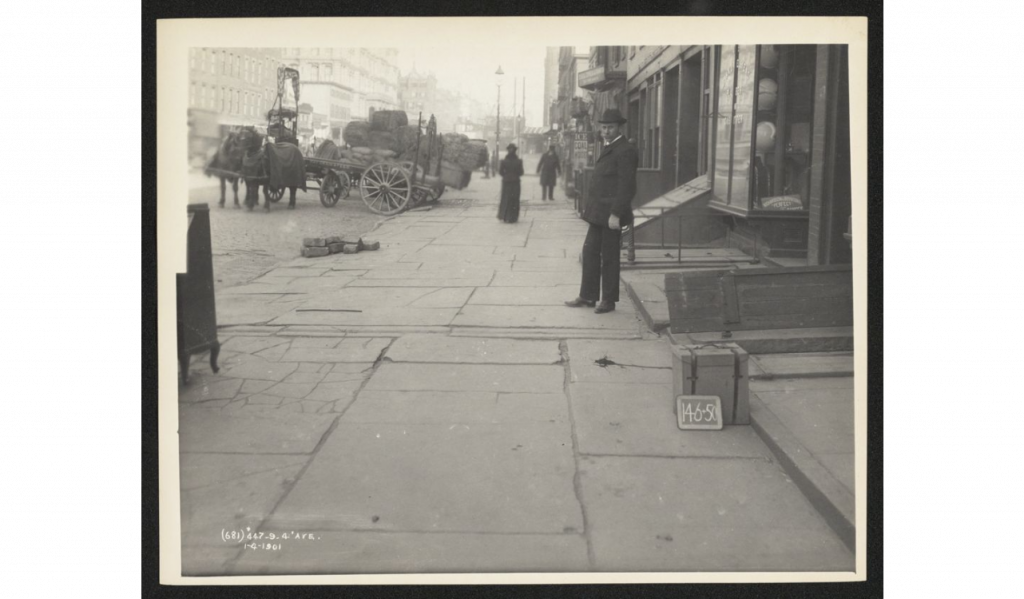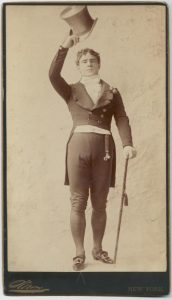32
18910129 See an image of the original letter, http://dx.doi.org/10.17613/x4cd-v709
No 2 New York
29th Jany. 1891
My dear Mother,
I sent you a long letter last Sat’day (No 1) by the “Gallia”, – & I wrote since to Father by the “Germanic”. Addie had arranged such a continuous round of dissipation for me that I had no time to write to you by the last mentioned boat.
I shall try to give you some account of our doings beginning with last night’s gaiety, partly because it is still fresh & partly as no doubt it will interest you more than anything else; – that is James Black’s wedding.
Addie had received his invitation some ten days ago. I did not call on Black as I did not wish to seem as if I were fishing, but he heard of my arrival from Tom Wallace & at once sent me cards which I enclose, to show you “how to do it”.

We did not go to the church but turned up towards nine at 65 East 55th Street. The house is one of a terrace in a very good part of New York. A carpet covered the steps, with a canopy overtied, leading into a small hall.[1] Adam Jenkins, acting as usher, took us up to the end of a small reception room where the bride & groom stood, supported by bride’s maids & groom’s men, to receive congratulations. The bride looked very pretty; she is of medium height, neither dark nor fair, & with that brightness of expression & thin-ness of face which are, it seems to me, typical of American women. It is with trembling that I attempt any description of dresses but as I know I should not be forgiven if I passed over in silence as important a matter, I took a few mental notes for your specific edification, & here I plunge.
The wedding garment was of white brocaded silk or satin covered with tulle, with a long square train; the veil was of white tulle fastened like a cap on the top of the head & flowing down the back. There was lace somewhere about the front, & the general effect of the picture was very good. The tulle softened the outlines & gave “atmosphere”, while the background of green palm-leave, and the light falling on the foreground & middle distance showed up the central figures to advantage.
The bride carried a large bouquet of lillies of the valley, & the groom wore a button hole of the same flower, while the bride’s maids had magnificent bouquets of Marechal Neill roses.[2]
There were, I think, six bride’s maids. One, a Miss Pulman, related to the Belfast people of that ilk, a pretty & very lively girl who reads Emerson but does not quite “grasp” some of his ideas, wore a white white Cachemire dress. She said she had made a bet with a gentleman that she herself would not be married within two years, & I advised her to hedge at once.
Two Miss Peacocks wore amber satin, – the upper part made sash-ways with white muslin. One lady had a handsome dress of pink satin with white ostrich feather trimming. Knowing what a Medici collar was, & thinking it would be a good word to bring into my description, I looked out for that rig, but I only noticed one built that way.[3] There were all kinds of colours, from mauve & green to crimson, & the most marked characteristic of the dresses all round, was their “strikingness”. There was no sameness, but lots of originality.
Now I have given you three pages on dress & for exhaustive, precise, & graphic description I take the Huntley Palmer; in fact I have shown what a letter from “our own lady correspondent” ought to be.
The floral decorations were very profuse. The stair-rail was covered with evergreens bound with pink ribbon, palm-fern leaves covered the walls. Over the entrance to the reception room was a bell of white flowers, mostly large lillies; on one wall the initials B & R were interlaced in white & red roses, & a medallion of the same flowers in concentrate rings hung on the wall behind the happy pair.
A band in the hall discourses sweet music at intervals; there was some kind of supper down below in the basement but as the crowd was thick I did not think it worth the crush to go down. The presents were displayed in a room upstairs & were, of course, numerous & costly, – excuse the startling novelty of the remark.
James Black’s brother, – Tom is his name, I think, – was very attentive throughout, introducing & asking people to go down to supper. Jack Savage was there in great form, also two Steins who enquired politely as to the well being of all the members of the family.
The couple left about midnight for the Southern States where they mean to spend their honey-moon, returning to New York for March & sailing in April for Belfast.
Mrs Russell seems a nice kindly elderly or rather middle aged lady; – I did not see anything of the other members of the family. [4]
Friday 30th Y’day afternoon I learnt of an alteration in the sailings of the Red D Line, which suddenly changes my plans. The last steamer that left broke her steaming gear the day after starting & had to return to New York, & my boat, the “Philadelphia”, sails tomorrow 31st, instead of Wednesday 4th, the other steamer will leave on the latter date. I have decided to sail tomorrow as the four days’ earlier arrival will suit me very well in the way of business, though the change upsets our pleasure arrangements & we shall have to cancel several engagements.

To re-commence at the beginning, on Friday evg. Addie took me to see Mansfield, a rising American actor, in “Beau Brummel”.[5] I enjoyed the performance thoroughly; the acting was capital, & the play, which is founded on fact, interesting throughout, & very amusing in parts, though quite sad at the end, where the poor Beau dies in poverty & neglect, though still keeping up, in his semi-madness, the artificial etiquette & the elaborate compliments of his old life as leader of fashion & tone at the court.
On Saturday we called on Tom Wallace.[6]
Must close this letter now in haste for tomorrow’s mail. Am now playing of billiards with Tom Wallace who sends his kind regards.
Addie writes by next mail due here a couple of days after this.
Best love
Jack
(the last lines scribbled untidily in pencil!)
- If you look on Street View on Google maps it is now in the heart of skyscraper Manhattan – and the home of “Park Avenue Tower” – rather hideous. Certainly nothing like the genteel terrace with carpeted stairs leading to the entrance! ↵
- The Maréchal Niel is a yellow climbing rose introduced in 1864. ↵
- A Medici collar is a fan-shaped collar that comes up dramatically behind the head. Originally an Elizabeth style, the general shape again became fashionable in the 18th century. ↵
- The identity of all mentioned individuals is uncertain. Many had Belfast connections at this very posh Black wedding. Tom Wallace probably Thomas Parker Wallace (see Index to People); James Black may be part of the Black family of the “heiresses” across the way from the Loewenthals in Belfast, perhaps their brother?; Adam Jenkins, acting as usher, most likely Adam Primrose Jenkins b~1865 Belfast (see Index to People); Tom (he thinks) Black, James Black’s brother; Mrs Russell, probably the mother of the American bride (“the initials B & R were interlaced in white & red roses”). ↵
- Beau Brummel: A Play in Four Acts written for Richard Mansfield by Clyde Fitch: https://en.wikipedia.org/wiki/Richard_Mansfield. Mansfield was born in Berlin and spent his early childhood on Heligoland, Germany, an island in the North Sea, then under British rule. His parents were Erminia Rudersdorff (1822–1882), a Russian-born operatic soprano, and Maurice Mansfield (d 1861), a British London-based wine merchant. His grandfather was the violinist Joseph Rudersdorff. Mansfield was educated at Derby School, in Derby, England, where he studied painting in London. His mother took him to America, where she was performing, but he returned to England at age 20. Finding that he could not make a living as a painter, he gained some success as a drawing-room entertainer, eventually moving into acting. ↵
- See Index to People. Probably Thomas Parker Wallace, commission merchant b 1846, married in Belfast. ↵
